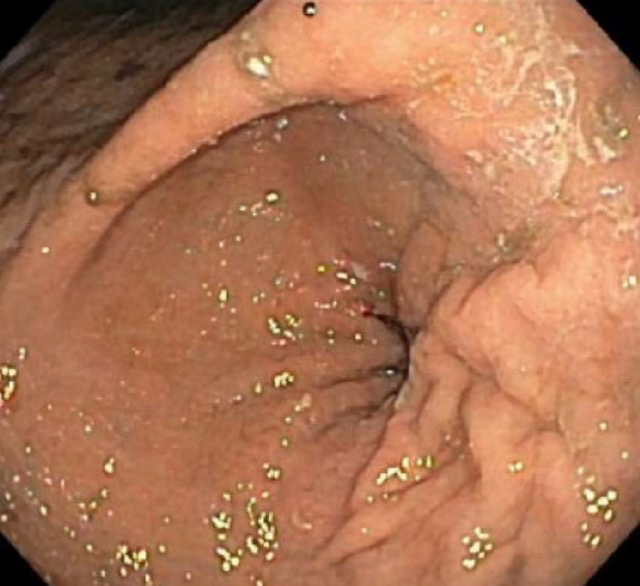Tuesday Poster Session
Category: Stomach and Spleen
P6342 - Metastatic Breast Cancer Masquerading as Gastric Outlet Obstruction
Tuesday, October 28, 2025
10:30 AM - 4:00 PM PDT
Location: Exhibit Hall
- SM
Samyuktha Manikandan, MD (she/her/hers)
Temple University Hospital
Philadelphia, PA
Presenting Author(s)
Samyuktha Manikandan, MD, Benjamin M. Yeager, MD, Frank Friedenberg, MD
Temple University Hospital, Philadelphia, PA
Introduction: Breast cancer is one of the most common cancers in the world. It generally metastasizes to bone, lung, and brain, but it rarely spreads to the stomach, with reported rates of approximately 1%. This case depicts breast cancer presenting as a gastric mass causing a gastric outlet obstruction.
Case Description/
Methods: An 84-year-old female presented with 14 days of persistent, postprandial nausea and vomiting. CT imaging depicted concentric thickening and narrowing of the gastric antrum with a gastric outlet obstruction (GOO). An endoscopy revealed LA grade D esophagitis and congested mucosa in the antrum and pyloric channel. Bite-on-bite biopsies were unrevealing. The etiology of her GOO was thought to be from post-viral gastroparesis; however, despite supportive care, her symptoms persisted. An endoscopic ultrasound (EUS) showed hypoechoic thickening of the gastric wall in the superficial and deep mucosal layers (1-3) with perigastric adenopathy. Cytology via fine needle aspiration (FNA) favored poorly differentiated metastatic lobular carcinoma of the breast, with the primary tumor confirmed by mammography. An endoscopic duodenal stent was placed to aid in gastric decompression; however, due to re-stenosis, she eventually required EUS-guided gastrojejunostomy (EUS-GJ) with a lumen-apposing metal stent (LAMS). This proved to be durable and effective as she continued with her workup and treatment of her primary breast cancer.
Discussion: This case highlights a diagnostically challenging presentation of GOO secondary to metastatic breast cancer. In prior studies, endoscopy usually shows localized lesions, diffuse infiltration, and external compression such that targeted biopsies with immunohistochemical staining yield a diagnosis. Unfortunately, in our case, bite-on-bite biopsies were insufficient, such that dedicated EUS with FNA was required. It also emphasizes the need for more dedicated imaging and sampling via EUS/FNA when initial biopsies are negative and there is a high index of suspicion for malignancy. Lastly, EUS-GJ proved to be an effective intervention in managing this patient’s GOO symptoms, even though data is scarce for this modality of gastric decompression in patients with metastatic cancer, specifically lobular breast cancer.

Figure: Congested Mucosa in The Antrum and Pyloric Channel
Disclosures:
Samyuktha Manikandan indicated no relevant financial relationships.
Benjamin Yeager indicated no relevant financial relationships.
Frank Friedenberg indicated no relevant financial relationships.
Samyuktha Manikandan, MD, Benjamin M. Yeager, MD, Frank Friedenberg, MD. P6342 - Metastatic Breast Cancer Masquerading as Gastric Outlet Obstruction, ACG 2025 Annual Scientific Meeting Abstracts. Phoenix, AZ: American College of Gastroenterology.
Temple University Hospital, Philadelphia, PA
Introduction: Breast cancer is one of the most common cancers in the world. It generally metastasizes to bone, lung, and brain, but it rarely spreads to the stomach, with reported rates of approximately 1%. This case depicts breast cancer presenting as a gastric mass causing a gastric outlet obstruction.
Case Description/
Methods: An 84-year-old female presented with 14 days of persistent, postprandial nausea and vomiting. CT imaging depicted concentric thickening and narrowing of the gastric antrum with a gastric outlet obstruction (GOO). An endoscopy revealed LA grade D esophagitis and congested mucosa in the antrum and pyloric channel. Bite-on-bite biopsies were unrevealing. The etiology of her GOO was thought to be from post-viral gastroparesis; however, despite supportive care, her symptoms persisted. An endoscopic ultrasound (EUS) showed hypoechoic thickening of the gastric wall in the superficial and deep mucosal layers (1-3) with perigastric adenopathy. Cytology via fine needle aspiration (FNA) favored poorly differentiated metastatic lobular carcinoma of the breast, with the primary tumor confirmed by mammography. An endoscopic duodenal stent was placed to aid in gastric decompression; however, due to re-stenosis, she eventually required EUS-guided gastrojejunostomy (EUS-GJ) with a lumen-apposing metal stent (LAMS). This proved to be durable and effective as she continued with her workup and treatment of her primary breast cancer.
Discussion: This case highlights a diagnostically challenging presentation of GOO secondary to metastatic breast cancer. In prior studies, endoscopy usually shows localized lesions, diffuse infiltration, and external compression such that targeted biopsies with immunohistochemical staining yield a diagnosis. Unfortunately, in our case, bite-on-bite biopsies were insufficient, such that dedicated EUS with FNA was required. It also emphasizes the need for more dedicated imaging and sampling via EUS/FNA when initial biopsies are negative and there is a high index of suspicion for malignancy. Lastly, EUS-GJ proved to be an effective intervention in managing this patient’s GOO symptoms, even though data is scarce for this modality of gastric decompression in patients with metastatic cancer, specifically lobular breast cancer.

Figure: Congested Mucosa in The Antrum and Pyloric Channel
Disclosures:
Samyuktha Manikandan indicated no relevant financial relationships.
Benjamin Yeager indicated no relevant financial relationships.
Frank Friedenberg indicated no relevant financial relationships.
Samyuktha Manikandan, MD, Benjamin M. Yeager, MD, Frank Friedenberg, MD. P6342 - Metastatic Breast Cancer Masquerading as Gastric Outlet Obstruction, ACG 2025 Annual Scientific Meeting Abstracts. Phoenix, AZ: American College of Gastroenterology.
